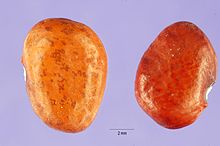Phaseolus acutifolius

Phaseolus acutifolius, or the Tepary bean, is a legume native to the southwestern United States and Mexico and has been grown there by the native peoples since pre-Columbian times. It is more drought-resistant than the common bean (Phaseolus vulgaris) and is grown in desert and semi-desert conditions from Arizona through Mexico to Costa Rica. The waters requirements are low and the crop will grow in areas where annual rainfall is less than 400 mm (16 in).
The tepary bean is an annual and can be climbing, trailing, or erect with stems up to 4 m (13 ft) long. The specific epithet, acutifolius, is derived from Latin acutus (pointed, acute), and -folius (-leaved).[3] A narrow leafed, variety tenuifolius, and a broader leafed, variety latifolius, are known. Domestic varieties are derived from latifolius. In the Sonora desert, “the flowers appear with the summer rains, first appearing in late August, with the pods ripening early in the fall dry season, most of them in October.”[4] The beans can be of nearly any color. There are many local landraces. Beans vary in size but tend to be small. They mature 60 to 120 days after planting.[5]
Other names for this native bean include Pawi, Pavi, Tepari, Escomite, Yori mui, Yorimuni and Yori muni. The name tepary may derive from the Tohono O’odham phrase tʼpawi or “It’s a bean”.[6] The name for a small bean was recorded in the 17th century, in the now extinct Eudeve language of northern Mexico, as tépar (accusative case, tépari).[7] Names that contain yori in them typically refer to non-native species of beans since those names mean “non-Indian person’s bean”.[8]
